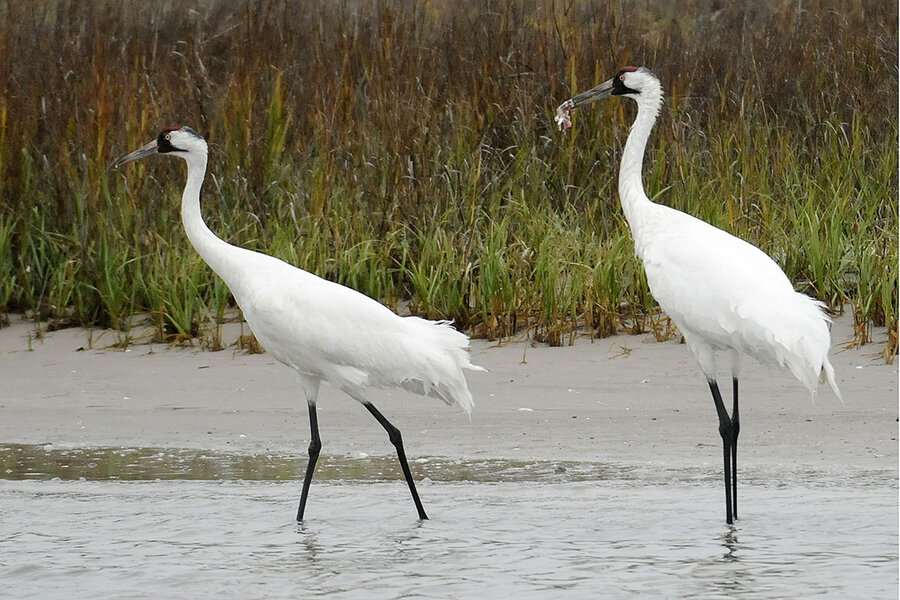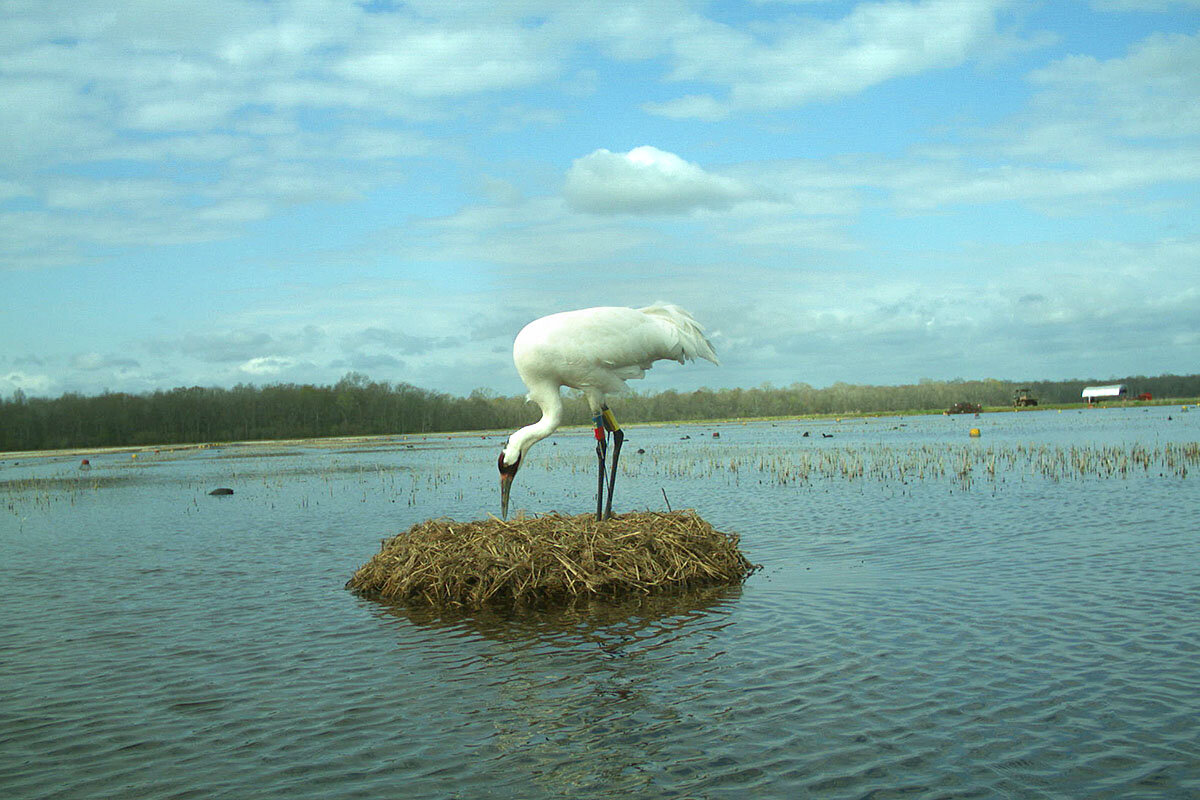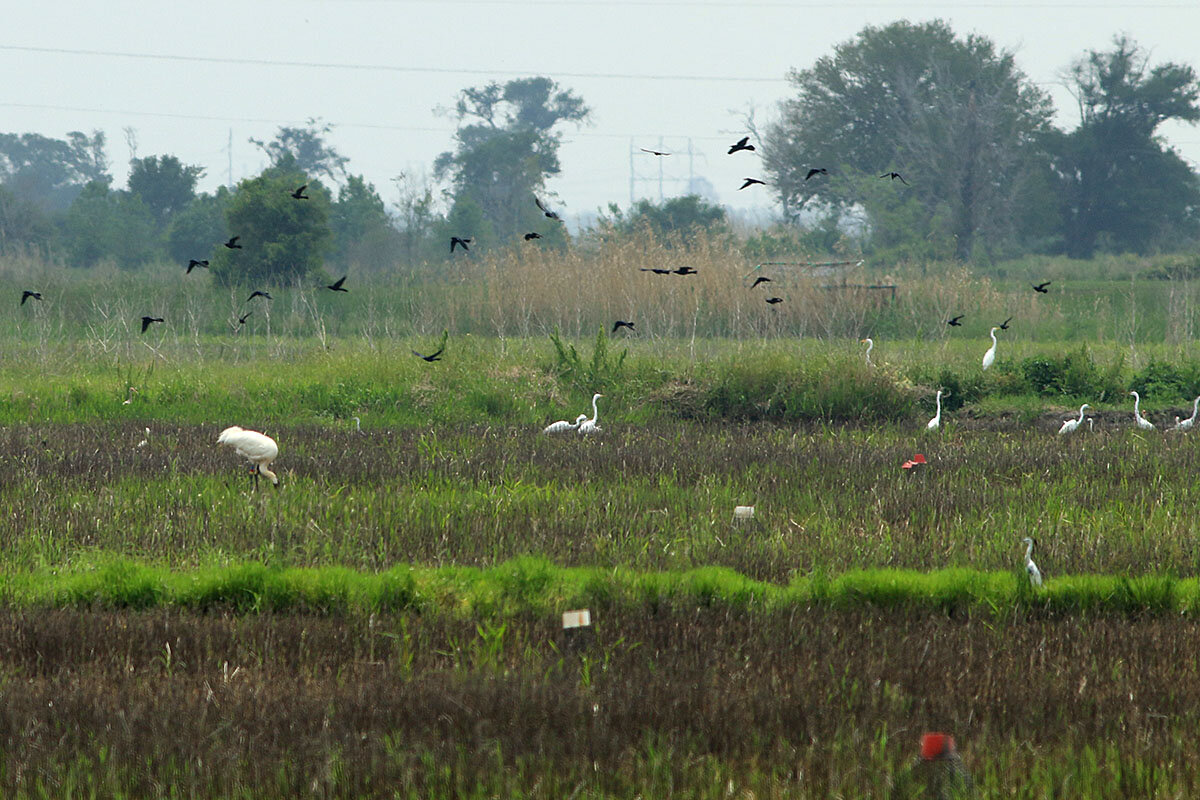‘This is a great story’: Whooping cranes make a comeback
Loading...
| Irving, Texas
Last month, on a pair of rice and crawfish fields in southeast Texas, mounds of vegetation a few feet tall made modern history. The mounds were nests, built over the course of several days by two pairs of whooping cranes from Louisiana.
“Historically there probably were whooping cranes nesting in Texas, but it’s been an awful long time since that’s happened,” says Wade Harrell, whooping crane recovery coordinator at the U.S. Fish and Wildlife Service.
“They’re resilient, and they can use a variety of different habitats,” he adds. “The species is on a comeback.”
Why We Wrote This
Finding the right rules of engagement between people and animals is key to bringing endangered species back to healthy numbers. One corner of the Gulf Coast is trying to get it right.
That’s cause for cautious optimism among conservation groups and government agencies that have been working for years – increasingly in partnership with private landowners – to bring the species back from the brink of extinction.
The endangered whooping crane – North America’s tallest bird – last laid eggs in Texas in the late 1800s, it’s believed. Back then, the bird’s mournful, croaking call was widespread on the continent. Every spring they would migrate from the Gulf Coast to nesting grounds in the northern United States and Canada, returning to the Gulf every winter.
But by World War II, there were fewer than 20 wild whooping cranes left, due to overhunting and the conversion of wetlands to farmland in the American Midwest.
Cranes make a comeback
Reintroduction efforts have made slow but steady progress. Globally, whooping cranes now number over 800, according to the International Crane Foundation (ICF). Among the largest populations in the U.S. are a migratory group that overwinter in and around the Aransas National Wildlife Refuge near Corpus Christi, Texas, and a nonmigratory group that was reintroduced to a marshland conservation area in southwest Louisiana in 2011.
Whooping cranes prefer to live in big, shallow, freshwater marshes. They’re vulnerable to predators and take a relatively long time to reproduce, not reaching adulthood for several years. Then, they have to find a mate for life, and many cranes are often unsuccessful with their first nests. It can take years for a pair to successfully raise a chick.
“Everything with whooping cranes takes time,” says Sara Zimorski, a biologist with the Louisiana Department of Wildlife and Fisheries. “So we’re still somewhat on the front end of this whole thing.”
“There are challenges and things that need to improve, but we’re seeing some progress,” she adds.
The two pairs that nested in Texas this year crossed the border from Louisiana. Their nests weren’t successful – membrane and eggshell pieces on one nest suggest a chick hatched but didn’t live very long, according to Ms. Zimorski. But because both pairs were nesting for the first time, it wasn’t that surprising, she says.
“They get better with age and experience,” she adds. “Hopefully even a little experience with hatching a chick will give them a boost in the future.”
Calibrating crane and human interactions
Challenges do remain. People have shot and killed 14 cranes in the Louisiana group, which for a population of about 75 is a sizable loss. Public awareness and education are priorities for local conservationists and government agencies moving forward.
As whooping cranes become more numerous, they will inevitably come into closer contact with humans, with some choosing to settle on private land. To encourage a welcoming environment for the birds, a government program provides financial and technical assistance if landowners agree to preserve part of their land as wildlife habitat. Rules of engagement have to be clearly laid out, experts say, particularly during the sensitive spring nesting period.
“Like parents ourselves, that early stage is tiring and stressful, but worthwhile in the end,” says Dr. Harrell. “Let them do their thing so they can raise that next generation.”
Compared with recent history, at least, these are good problems. Young whooping cranes expanding their range means more interactions with humans, but it also means a catastrophic event like a hurricane won’t wipe out the entire species.
And it’s evidence that as the whooping crane population recovers, it’s also adapting to the modern era. Only 10 or 15 years ago, experts thought cranes might restrict themselves to coastal marshes. Now, they’re overwintering 80 miles from the Gulf and nesting in crawfish farms.
“The fact that they’ve gotten to this age, have bonded, and are doing what cranes are supposed to do, that’s just a milestone. It’s just fantastic,” says Liz Smith, ICF’s North America program director, based near Corpus Christi.
ICF has focused in recent years on raising public awareness of the migratory group that overwinters near the Texas Gulf Coast. Now, as that population expands up the coast toward Houston, ICF is expanding its operations up the coast as well. This year it hired its first staff member in Louisiana. “It’s not inconceivable,” says Dr. Smith, that the Texas group and the Louisiana group “will meet and overlap, which would be a great conservation success.”
As exciting as that prospect may be, it’s worth reflecting on how far whooping cranes have come, says Jeffrey Wozniak, an ecosystem ecologist at Sam Houston State University. The Texas population has doubled since he started researching it 14 years ago. A species that numbered under two dozen has increased roughly fiftyfold in 80 years.
“It shows you what hard work and good collaboration can result in,” adds Dr. Wozniak. “This is a great story.”








